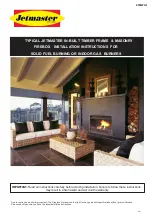
12
250-3692 (11/2000) DVi32 Gas Insert
It is very important to maintain a balance between the com-
bustion air intake and the flue gas exhaust venting system.
The DVI-32 must be vented vertically, using Simpson Dura-
Vent direct vent systems through a masonry fireplace or metal
zero-clearance fireplace or can be installed using Simpson
Dura-Vent GS series pipe in conjunction with Quadra-Fire zero
clearance can.
NOTE: Certain limitations as to vent and vertical termina-
tion configuration apply, and must be strictly adhered to.
When planning your installation, it will be necessary to select
the proper length of vent pipe for your particular requirements.
To determine the length of your pipe required for vertical
installations, measure the distance from the application flue
outlet to the ceiling, the ceiling thickness, the vertical rise in
an attic or second story, and allow for sufficient vent height
above the roofline (2’ above 10’ [610mm above 3048mm] is
standard). For two-story applications, fire stops are required
at each floor level. If an offset is needed in the attic, additional
pipe and elbows will be required.
When installing this appliance into an existing masonry
chimney or zero clearance chimney, it is important to carefully
measure the length of flex needed to reach from the appliance
outlet to the termination cap. If the flex length is too short, a
flex coupler will be needed to attach an additional length of
flex liner to make up the difference. If the flex length is too
long, the liner could sag below the appliance outlet, which
could result in a potential fire hazard and restriction of
combustion air needed by the appliance.
When dropping the flex venting, be sure to label the line to be
used for exhaust at the top and bottom. If the venting is
attached incorrectly, flame lift and flow reversal may occur.
NOTE: For installation into a zero clearance chimney, using
two flex liners, you must have at least a 7” (178mm) ID in
order to run the two lines of flex liner needed.
MASONRY INSTALLATION
PLANNING YOUR INSTALLATION
VERTICAL TERMINATIONS
USING GS SERIES PIPE IN CONJUNCTION WITH
QUADRA-FIRE ZC CAN
Step 1.
Check the installation instructions for required
clearances (air space) to combustibles when
passing through ceilings, walls, roofs, enclosures,
attic rafters, or other nearby combustible surfaces.
Do not pack air space with insulation.
NOTE
:
Maximum vertical rise allowable is 30’ (9144mm)
(Figure 1). Maximum number of 45° elbows
permitted for a vertical installation is two. These
elbows do not decrease allowable maximum vertical
rise.
FIG. 1
f i r e - p a r t s . c o m






































